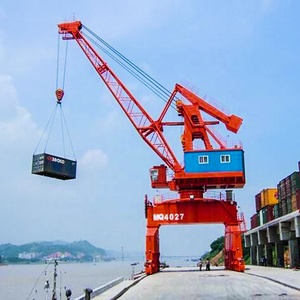(1153 products available)




























































































































































The harbor crane is a special type of lifting machine used to transfer containers from ships to land and vice versa. They are mainly used for importing/exporting goods at seaports. Containers can be easily transferred to/from the ship using harbor cranes. The following are the most common types of harbor cranes used worldwide:
Floating Crane:
A floating crane is a specialized type of harbor freight crane integrated into a massive barge. This versatile piece of equipment is engineered to facilitate the loading and unloading of ships while they are anchored in open waters.
Trailer-Mounted Harbor Crane:
The trailer-mounted harbor crane is a versatile piece of equipment that can be transported to different locations by attaching it to a trailer. These cranes are commonly utilized in various maritime applications such as vessel unloading, container handling, and general cargo management. One of the standout features of the trailer-mounted harbor crane is its ability to be easily transported by road or sea to different locations where it is needed.
Harbor Mobile Crane:
A mobile harbor crane is an omnidirectional handling system that has been specifically designed for the bulk and container industries. This versatile and efficient piece of equipment is capable of meeting any operational requirement with ease. Mobile harbor cranes are available in a variety of configurations to suit different handling needs and environments.
Rubber-Tyred Gantry Crane (RTG):
The RTG crane is a harbor crane that uses wheels for movement. It's a gantry crane that can handle containers stacked on trailers or at ports with multiple horizontal and vertical lines of containers. Because they are more mobile than rail gantry cranes, rubber-tyred gantry cranes are well-suited for moving containers from ships to inland transportation networks.
Usually, a harbor or port crane's specifications will include its maximum lift capacity. This figure is probably the most vital piece of information for a cargo vessel. It reflects the heaviest weight of a single container the crane can handle. It does not mean that the crane can only lift containers of that weight. A crane with a 60-ton capacity will easily lift a fully loaded container that weighs less than 60 tons. However, if port authorities need to lift a container that weighs more than 60 tons, they may be able to offload its contents to bring its weight within the crane's capacity.
The maximum height from which a crane can or will safely lower cargo is usually referred to as its outreach. This is especially important for ship-to-shore cranes, as there may be restrictions on the height of cargo that can be safely lifted from a particular type of ship.
Other parameters include the following:
Maintenance:
The correct operation and maintenance of harbor cranes ensure port logistics run smoothly. Regular servicing is equally important to avoid delays or accidents. In addition to regular scheduled maintenance, some tips include the following:
As the primary loading and unloading equipment for various goods and containers at ports, the application scenarios of harbor cranes are as follows:
Cargo management is crucial for the smooth operation of any harbor. To this end, harbor cranes are indispensable pieces of equipment. However, when purchasing these machines, it is imperative to consider the following factors to ensure that the right crane is chosen for the harbor's needs:
By considering these factors and matching them to harbor requirements and budgets, the most suitable type of crane can be selected, and it will work efficiently in tandem with the rest of the cargo systems to facilitate trade and transportation.
Q1: What are the recent trends in harbor crane design and construction?
A1: The latest trends in the design and construction of harbor cranes include increasing automation, sustainability and energy efficiency, smart port technology, and enhancements to operator safety and comfort.
Q2: What is the lifespan of a typical harbor crane?
A2: A well-maintained harbor crane can have a lifespan of 25-30 years or more.
Q3: What are the major components of a harbor crane?
A3: The main components of a harbor crane include the base, support structure, hoisting system, control system, and power supply system.
Q4: What is the difference between a pneumatic and hydraulic crane?
A4: Harbor cranes are often classified into two basic categories: fixed and mobile. A mobile harbor crane is a machine that can be moved around the port area to lift, transfer, and move containers. A mobile harbor crane operates by using the energy of wind and gas, and it is free to move around the port area. The mobile harbor crane uses a gas-powered engine that runs on natural gas to propel itself in the harbor. Gas turbines create high-pressure air, which is used to drive the turbine and propel the crane. Mobile cranes are large pieces of equipment that can be moved from one location to another. They are usually mounted on a chassis or a wheeled platform that allows them to be driven around the port area. A fixed harbor crane is a machine that is permanently installed in the port to lift, transfer, and move containers. The fixed harbor crane is usually mounted on a large concrete platform that is anchored to the ground. This type of crane is used to move large cargo ships that are anchored at sea and transfer containers from the ship to the shore or vice versa.